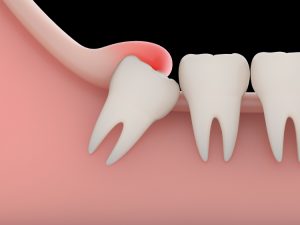Sock it to Dry Socket – Consumer Guide Words of Wisdom
Written by Consumer Guide to Dentistry Last modified on October 10, 2018
If you are an adult and still have your wisdom teeth, you are in the minority. The common surgery is recommended by most oral and maxillofacial dentists, which explains why nearly five million people undergo removal each year. You might even say that electing to undergo extraction is a wise choice.

Wisdom teeth typically don’t develop until after the age of 17, and when they do, they can often cause oral health issues. They may not erupt fully from the gum tissue, they may come in at the wrong angle and press up against adjacent teeth… sometimes the size of the mouth is too small to accommodate the growth of additional molars. For such issues, wisdom tooth extraction is an obvious solution.
Although it’s an extremely common procedure, it’s not without risk and has several potential side effects, including a condition known as dry socket.
When a wisdom tooth (or any tooth for that matter) is removed, it creates an empty socket. This open space exposes underlying bone and nerves previously protected by the tooth. After extraction, a blood clot forms in place of the tooth to serve as the protective barrier. This clot can become dislodged or even dissolve in the days after surgery, leaving the underlying bone and nerves unprotected, and at risk for infection. This condition can be extremely uncomfortable and painful, but fortunately it only affects 2 to 5% of extraction patients.
If you’ve ever experienced tooth sensitivity caused by hot/cold liquids, air or food, you have a sense of the sort of discomfort an exposed socket can cause. If infected, this discomfort can be amplified significantly to the point of throbbing, constant pain. It can also cause a bad taste in your mouth caused by food debris getting stuck in the socket, which in turn can lead to bad breath. Those most at risk include:
- Smokers (nicotine reduces blood supply & inhibits healing)
- Women using birth control pill
- People with poor oral hygiene
- People over the age of 30
- Particularly difficult extractions requiring removal of gum tissue / jawbone
Overly aggressive hygiene or eating/drinking habits may also increase the risk of dry socket. For example, if you drink through a straw frequently after extraction, the pressure could disrupt the clot. Similarly, frequent rinsing and spitting with mouthwash or water can also be problematic. Paying attention to these risk factors can better help you prevent any post-surgery socket problems.
In terms of treatment, your dentist will irrigate the infected socket, then apply a medicated dressing to assist with healing. This dressing is typically coated with an analgesic to numb any lingering discomfort. The dressing will typically need to be replaced every couple of days until the socket has fully healed. Pain relievers and/or antibiotics may also be administered as part of treatment. Most cases of dry socket should clear up with treatment over one-to-two weeks.
If you’ve had your wisdom teeth removed and are experiencing ongoing pain several days after surgery, speak with your dentist as soon as possible. The quicker you can identify and begin treating dry socket, the quicker your recovery will be.


